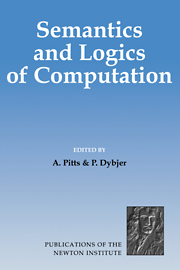Book contents
- Frontmatter
- Contents
- List of Contributors
- Preface
- Semantics of Interaction: an Introduction to Game Semantics
- Computational Content of Classical Logic Thierry Coquand
- Syntax and Semantics of Dependent Types
- Game Semantics
- Metalanguages and Applications
- Operationally-Based Theories of Program Equivalence
- Categories in Concurrency
- Index
Metalanguages and Applications
Published online by Cambridge University Press: 15 September 2009
- Frontmatter
- Contents
- List of Contributors
- Preface
- Semantics of Interaction: an Introduction to Game Semantics
- Computational Content of Classical Logic Thierry Coquand
- Syntax and Semantics of Dependent Types
- Game Semantics
- Metalanguages and Applications
- Operationally-Based Theories of Program Equivalence
- Categories in Concurrency
- Index
Summary
Introduction
The aim of these notes is to describe the monadic and incremental approaches to the denotational semantics of programming languages. This is done via the use of suitable typed metalanguages, which capture the relevant structure of semantic categories. The monadic and incremental approaches are formulated in the setting of a type-theoretic framework for the following reasons:
a type theory with dependent types allows a precise, concise and general description of the two approaches, based on signatures as abstract representations for languages;
there are various implementations (e.g. LEGO and CoQ) which provide computer assistance for several type-theories, and without computer assistance it seems unlikely that either of the two approaches can go beyond toy languages.
On the other hand, the monadic and incremental approaches can be described already with a naive set-theoretic semantics. Therefore, knowledge of Domain Theory and Category Theory becomes essential only in Section 6.
The presentation adopted differs from advanced textbooks on denotational semantics in the following aspects:
it makes significant use of type theory as a tool for describing languages and calculi, while this is usually done via a set of formation or inference rules;
it incorporates ideas from Axiomatic and Synthetic Domain Theory into metalanguages, while most metalanguages for denotational semantics are variants of LCF;
it stresses the use of metalanguages to give semantics via translation (using the monadic and incremental approaches), but avoids a detailed analysis of the categories used in denotational semantics.
- Type
- Chapter
- Information
- Semantics and Logics of Computation , pp. 185 - 240Publisher: Cambridge University PressPrint publication year: 1997
- 8
- Cited by

